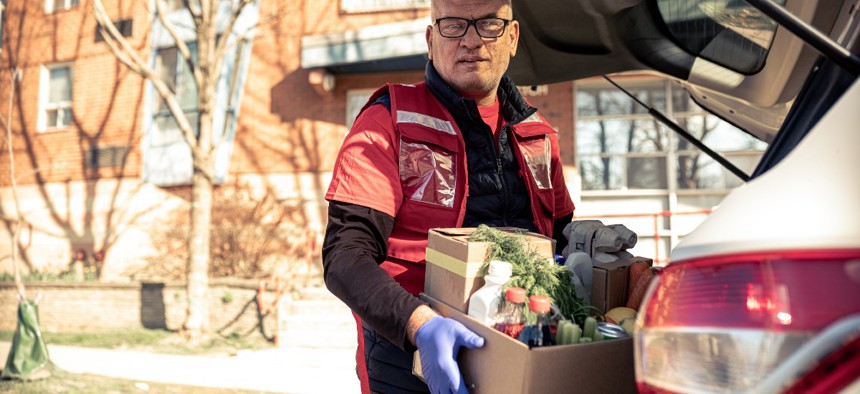Code for America Unveils First States in Safety Net Cohort

FOTOGRAFIA INC./Getty Images
The nonprofit aims to help states build digital tools and services to connect people with health, food assistance and other benefits programs.
Code for America announced four of the five members of its first Safety Net Innovation Lab cohort.
Through $100 million in investments from The Audacious Project and Blue Meridian Partners, announced last month, CfA is launching the lab with the goal of unlocking $30 billion in benefits in the areas of food assistance, health care and other needs. The lab will partner with three cohorts of five states each, reaching about 13 million people.
The first group includes California, Colorado, Connecticut and Louisiana, with the fifth to be announced later this summer. CfA and the California Department of Social Services will work to improve the Supplemental Nutrition Assistance Program (SNAP) outreach to hard-to-reach populations, while CfA will work with the Louisiana Department of Children and Family Services to streamline SNAP digital tools and speed application processing time. In Colorado, CfA will help with an integrated online benefits application, and in Connecticut, it will focus on increasing participation in food assistance programs by eligible people.
“The understanding of what it means to partner is shifting at Code for America, as it is with our state partners,” said Alexis Fernandez Garcia, senior program director leading CfA’s social safety net portfolio. “You’re seeing us rethink the technology we’re using, you’re seeing us rethink our investment in sustainability and handing tools off to the state.”
A CfA team is in the process of doing just that in Minnesota, where they’ve been working since 2019 on a revamp of the state’s digital benefits application, MNbenefits. Previously, applicants had to log in to access the English-only website using a desktop computer and be ready to upload all of their verifying documents at one time. It typically took about an hour to complete an application, said Dustin Palmer, an associate program director for CfA’s Integrated Benefits Initiative.
Now, applicants typically spend 13 minutes on their applications, which they can submit through mobile devices without having to log in just to reach the tool, he said. Plus, CfA put in place LaterDocs, which allows applicants to upload documents as needed. Additionally, the site is fully translated into Spanish and two tribal nations have an online option for benefits for the first time.
The old application was retired in February, and more than 1,000 use the new one each day.
“The one thing that I think is really neat about this project, too, is that intention of building capacity within the government,” Palmer said. “This isn’t a license we’re selling. It’s something built with Minnesota that they will own from the beginning.”
To do that, the team worked side by side with Minnesota IT Services (MNIT).
“We’ve really been able to bring them along in the way we develop software,” said Luigi Ray-Montanez, a CfA engineering manager. “For example, we do modern rituals from the software industry like daily standups and pair programming here at CfA, and we’ve had Minnesota colleagues with us doing those.”
Pair programming is an agile software development technique in which two programmers share a workstation.
As a result, both CfA and MNIT workers learned how best to work together but also identified blockers with some processes. For instance, the state had some virtual development environments that were outdated, slow and hard to use, Ray-Montanez said.
“We identified the issue with Minnesota. We told them about how there was this clear loss of productivity for their engineers, and to their credit, they addressed those gaps,” he said. “They got their engineers better hardware, virtualization options to use, and now there’s much more parity.”
Ray-Montanez said he expects the full handoff to MNIT to happen within the next few months. In February, the team ran a two-week “fire drill” in which CfA stepped back while MNIT ran a release, or website update. Whereas that used to happen once a quarter with much planning, in 2021, there were 56, Palmer said.
“It’s getting better based on real people’s feedback and that’s a cadence we’re trying to keep up,” he said of the website. “It’s a way to de-risk a projects, to help you when something goes wrong and just keep iteratively improving and focus the work.”
To prepare for the handoff, MNIT is hiring for new positions, including a digital experience product designer, a data scientist and a product manager.
“For Code for America, it really is a new and groundbreaking thing to hand off a full piece of software, running live service to a state IT organization,” Ray-Montanez said.
CfA launched a request for information that is open until July 8 for states interested in participating in the Safety Net Innovation Lab. The second cohort will be announced next year and the third a year after that, Fernandez Garcia said.
The work will begin with a discovery phase in which CfA “digs into what the problem looks like on the ground, what the client population says the needs are and what we might refine as an intervention,” she said. After that, the team will have a clear idea of what tools might be of use.
Access to social benefits isn’t easy, CfA Chief Executive Office Amanda Renteria said in a recent TED Talk, “so it’s no wonder that 14 million Americans aren’t enrolled in child and food nutrition programs, or that 6 million are missing health care benefits. Technology has changed almost every aspect of our lives. It’s made things faster, more efficient, automatic. We need to do the same for people seeking benefits.”
Stephanie Kanowitz is a freelance writer based in northern Virginia.
NEXT STORY: How broadband investments can reduce food deserts





